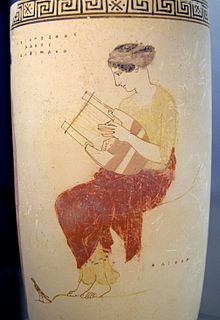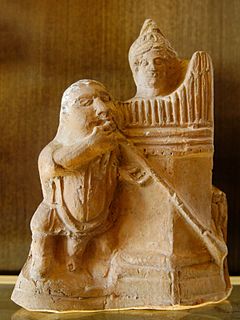
Acoustics is the branch of physics that deals with the study of all mechanical waves in gases, liquids, and solids including topics such as vibration, sound, ultrasound and infrasound. A scientist who works in the field of acoustics is an acoustician while someone working in the field of acoustics technology may be called an acoustical engineer. The application of acoustics is present in almost all aspects of modern society with the most obvious being the audio and noise control industries.
Epsilon is the fifth letter of the Greek alphabet, corresponding phonetically to a mid front unrounded vowel. In the system of Greek numerals it also has the value five. It was derived from the Phoenician letter He . Letters that arose from epsilon include the Roman E, Ë and Ɛ, and Cyrillic Е, È, Ё, Є and Э.

The tambourine is a musical instrument in the percussion family consisting of a frame, often of wood or plastic, with pairs of small metal jingles, called "zills". Classically the term tambourine denotes an instrument with a drumhead, though some variants may not have a head at all. Tambourines are often used with regular percussion sets. They can be mounted, for example on a stand as part of a drum kit, or they can be held in the hands and played by tapping or hitting the instrument.
Transliteration is a type of conversion of a text from one script to another that involves swapping letters in predictable ways.

The lyre is a string instrument known for its use in Greek classical antiquity and later periods. The lyre is similar in appearance to a small harp but with distinct differences. In organology, lyres are defined as "yoke lutes", being lutes in which the strings are attached to a yoke that lies in the same plane as the sound-table and consists of two arms and a cross-bar.

The bouzouki is a musical instrument popular in Greece that was brought there in the 1900s by Greek immigrants from Turkey, and quickly became the central instrument to the rebetiko genre and its music branches. A mainstay of modern Greek music, the bouzouki has a flat front, usually heavily inlaid with mother-of-pearl. The instrument is played with a plectrum and has a sharp metallic sound, reminiscent of a mandolin but pitched lower. There are two main types of bouzouki: the trichordo (three-course) has three pairs of strings and the tetrachordo (four-course) has four pairs of strings.

An aulos or tibia (Latin) was an ancient Greek wind instrument, depicted often in art and also attested by archaeology.

The music of ancient Greece was almost universally present in ancient Greek society, from marriages, funerals, and religious ceremonies to theatre, folk music, and the ballad-like reciting of epic poetry. It thus played an integral role in the lives of ancient Greeks. There are significant fragments of actual Greek musical notation as well as many literary references to ancient Greek music, such that some things can be known—or reasonably surmised—about what the music sounded like, the general role of music in society, the economics of music, the importance of a professional caste of musicians, etc. Even archaeological remains reveal an abundance of depictions on ceramics, for example, of music being performed.

The music of ancient Rome was a part of Roman culture from earliest times. Music was customary at funerals, and the tibia, a woodwind instrument, was played at sacrifices to ward off ill influences. Song (carmen) was an integral part of almost every social occasion. The Secular Ode of Horace, for instance, was commissioned by Augustus and performed by a mixed children's choir at the Secular Games in 17 BC. Under the influence of ancient Greek theory, music was thought to reflect the orderliness of the cosmos, and was associated particularly with mathematics and knowledge.

A salpinx was a trumpet-like instrument of the ancient Greeks.

The Lycian alphabet was used to write the Lycian language of the Asia Minor region of Lycia. It was an extension of the Greek alphabet, with half a dozen additional letters for sounds not found in Greek. It was largely similar to the Lydian and the Phrygian alphabets.

The Pyrrhichios or Pyrrhike dance was the best known war dance of the Greeks. It was probably of Dorian origin and practiced at first solely as a training for war. According to ancient sources it was an armed dance.

Castanets, also known as clackers or palillos, are a percussion instrument (idiophone), used in Spanish, Kalo, Moorish, Ottoman, Italian, Sephardic, Swiss, and Portuguese music. In ancient Greece and ancient Rome there was a similar instrument called crotalum. The instrument consists of a pair of concave shells joined on one edge by a string. They are held in the hand and used to produce clicks for rhythmic accents or a ripping or rattling sound consisting of a rapid series of clicks. They are traditionally made of hardwood, although fibreglass is becoming increasingly popular.

Stis Akres Ap' Ta Matia Sou is an international album by popular Greek artist Eleftheria Arvanitaki released in 2006 through her Verve Records contract under the EmArcy label. The album consists of 14 selected songs from her local 2005 compilation release, Dromoi Paralliloi, that reflect the wide interpretative qualities of Eleftheria with traditional and western rhythms.
Manousos Manousakis is a well-known Greek director, producer, writer and actor. He was born in Athens, Greece on 14 January 1950. He studied at the London Film School. His spouse is named Maria and they have two children. He is a nephew of Irene Papas and first cousin of Aias Manthopoulos. He is an avid sailor and has won several regattas.
George Pol. Papadakis is a Greek poet, writer and mathematician. He was born in Athens. He graduated from Lycee Leonin of Nea Smyrni and then went on to higher education. He believes that lifelong learning is the key to human fulfillment. His studies lead to this utopian direction.
The Big Streets is a 1953 Greek drama film directed by Grigoris Grigoriou and starring Dinos Dimopoulos, Liana Liapi and Giannis Argyris. It was neorealist in style. Its failure at the box office led Grigoriou to turn to making more potentially commercial films.












